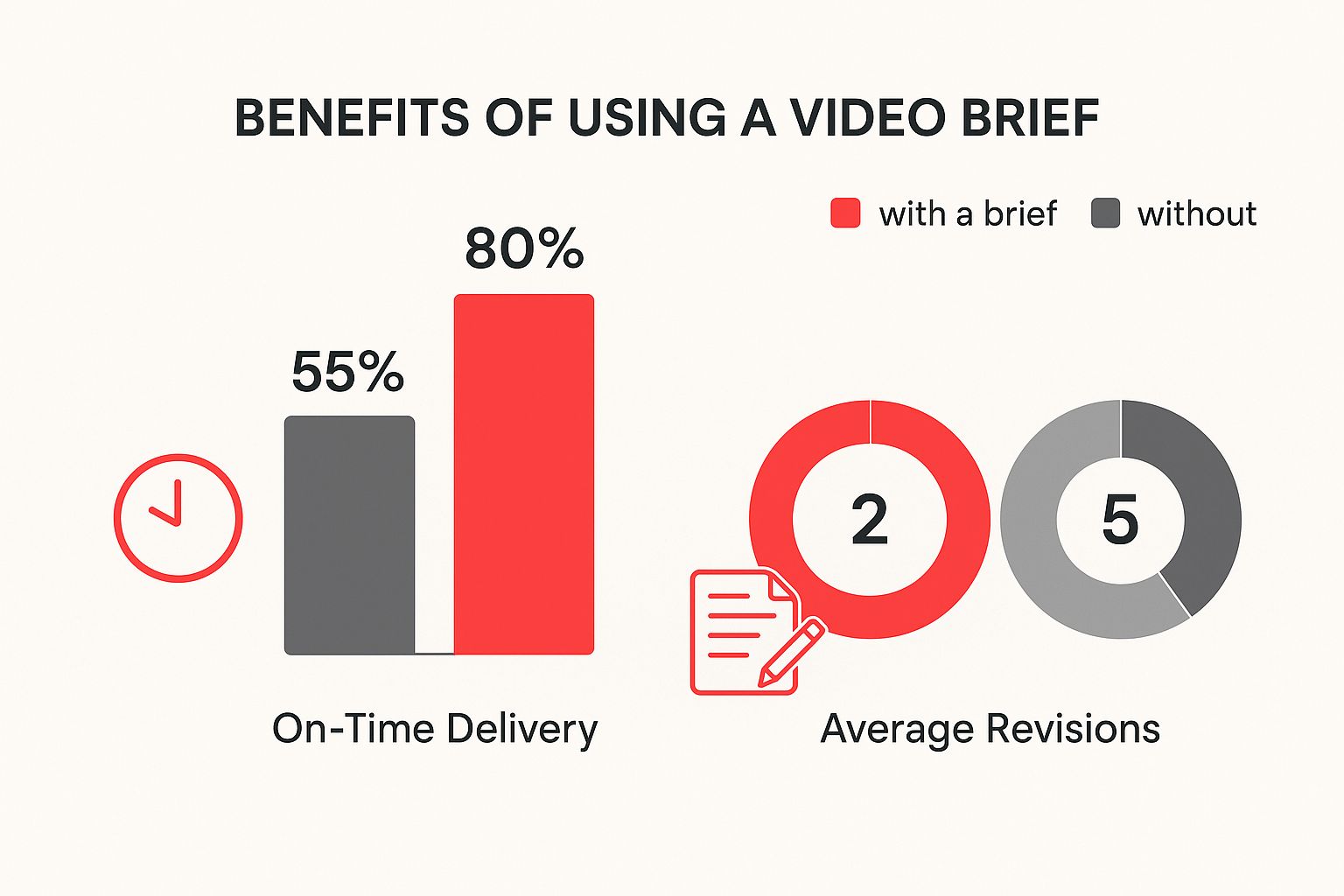 12 Best Affiliate Marketing Platforms for Creators in 2025
12 Best Affiliate Marketing Platforms for Creators in 2025
A video brief template is, at its core, a strategic document. It's the game plan you create that lays out every single critical piece of your video project before anyone even thinks about picking up a camera. Think of it as the foundational blueprint that gets your whole team on the same page, defines what success actually looks like, and sets crystal-clear expectations. The goal? Making sure your final video delivers real, measurable business results.
Table of Contents
Why a Great Brief is Your Project's North Star
Let's be real for a second. Most video projects that go off the rails fail long before the camera starts rolling. They stumble out of the gate because of fuzzy goals, mismatched expectations, and a total lack of a unified vision.
This is exactly where a solid video brief becomes your project’s most valuable player. It's your unbreakable contract with clarity, and it's so much more than just a box to check on your project plan.
A well-crafted brief, built from a good video brief template, is a powerful strategic tool. It’s your best defense against the dreaded "scope creep" that blows up budgets and torpedoes deadlines. It also dramatically cuts down on the need for expensive, time-sucking revisions later in the game.
A great brief doesn't just tell your creative team what to make; it tells them why it matters. This context is what separates okay content from content that actually gets people to do something.
When you take the time to define everything upfront, you're not limiting creativity. You're empowering your team with the freedom to come up with brilliant ideas inside a smart, strategic framework.
From Document to Blueprint for Success
Shifting your mindset from seeing the brief as just another document to seeing it as the blueprint for your project's success is absolutely crucial. This is how you guarantee a return on your investment. It means going beyond just the basic project details and really nailing down the strategic direction.
Without that direction, you're just making noise in an incredibly crowded market. The power of video is undeniable, but it takes careful, thoughtful planning to make it work for you.
And the stakes have never been higher. Video marketing is now a core strategy for almost everyone. In fact, around 89% of companies worldwide use video in their marketing. What’s more, 96% of marketers say it has directly increased their brand awareness, and a staggering 84% attribute direct sales increases to their video campaigns. These aren't just vanity metrics; they're proof that video works—when it's done right. You can discover more about how video drives business growth and see what these findings mean for your own strategy.
A great brief ensures your final video is a direct line back to your business goals. It forces alignment on the big stuff:
- Core Objectives: What is the number one business goal this video has to achieve? Is it leads, sales, sign-ups?
- Target Audience: Who, specifically, are we talking to? What do they care about? What keeps them up at night?
- Key Message: If the viewer remembers only one thing, what should it be?
- Creative Guardrails: What are the brand's non-negotiables? Are there any specific visual styles, tones, or words to avoid?
Laying all this out ensures that every decision made—from the first line of the script to the final cut—serves a very specific, strategic purpose.
Establishing Your Core Project Objectives

This is it. This is where you anchor your video’s entire reason for being. If you get this part wrong, everything that follows is just guesswork. Honestly, the "Primary Goal" field is the first place most video projects start to go off the rails.
Why? Because most people fill it with vague, fluffy statements like "increase brand awareness" or "drive engagement." These are project-killers. They're impossible to measure and give your creative team zero real direction.
To make a video that actually moves the needle, you have to tie it to a tangible business outcome. This simple shift in mindset is what separates a video that costs you money from one that makes you money.
Examples of Strong Primary Goals:
- Generate 150 marketing qualified leads (MQLs) from the campaign landing page within Q3.
- Reduce customer support tickets related to "software setup" by 20% in the next six months.
- Increase free trial sign-ups for our new feature by 35% in the first month post-launch.
Go Deeper Than Demographics with Your Audience
Alright, so you know what you want to achieve. Now, who do you need to convince? I see this all the time: "Women aged 25-40." That's not a target audience; it's a statistic from a census report. To make a video that truly connects, you need to think about a real person.
Your brief should force you to answer the deeper questions. What keeps this person up at night? What are their real-world frustrations? What social media platform are they scrolling through while waiting for their coffee?
Getting this level of detail is crucial. It informs every single creative choice, from the tone of the script to the background music. A video for a time-crunched startup founder is going to look and feel completely different from one aimed at a cautious, data-loving enterprise CFO.
The goal is to make your viewer feel completely seen and understood. When your video speaks directly to their specific problem, they’re far more likely to stick around for your solution.
Distill Everything Into a Single Key Message
With a sharp goal and a crystal-clear audience, the final piece of the foundation is your "Key Message." This is the one big idea you need your audience to remember, even if they forget everything else.
This isn't your flashy tagline or a clever slogan. It’s the core takeaway that directly supports your primary goal. Think simple, direct, and compelling.
Putting It All Together
Let's walk through a quick example. Imagine a SaaS company is launching a new project management tool. Here’s how these three critical elements might look in their video brief:
| Brief Section | Example |
|---|---|
| Primary Goal | Drive 500 new team sign-ups in the first 60 days. |
| Target Audience | "Maria," a 35-year-old marketing manager at a mid-sized tech company. She's overwhelmed by scattered communication across email, Slack, and spreadsheets, causing project delays and team frustration. |
| Key Message | Our new tool consolidates all project communication into one place, giving your team back its clarity and momentum. |
Nailing these foundational pillars in your video brief isn’t just some preliminary box-ticking exercise. It's genuinely the most important work you’ll do. It ensures every decision that comes next—from creative concepts to distribution channels—is strategic, focused, and built for success.
Alright, you've nailed down your goals and who you're talking to. Now comes the fun part: translating that strategy into a real, tangible creative vision. This is where we figure out the what and the where—the look, feel, and ultimate home for your video. Getting this section of your brief right is crucial because it ensures your creative ideas are actually built for the environments where they'll live.
It all starts with defining the video's tone and style. This isn't just about throwing a few adjectives on a page; it's about articulating the specific feeling you want your video to spark.
Are you going for something urgent and direct, like a fast-paced SaaS demo that cuts straight to a key feature? Or is the goal more inspirational and cinematic, like a brand anthem designed to forge a genuine emotional connection? Be specific.
Setting Creative Guardrails
Once the tone is set, the next step is to lay out any creative mandatories and restrictions. These are the absolute non-negotiables. Think of them as the guardrails that keep your project on-brand and legally compliant, without completely boxing in your production team's creativity.
This list needs to be crystal clear and cover essentials like:
- Brand Guidelines: Get specific. List the exact hex codes for colors, where logos must appear, and which fonts are approved.
- Legal Disclaimers: Is there any text that must be on screen? Things like "results not typical" or copyright notices need to be included here.
- Product Representation: Are there rules for how your product is shown? For example, a software company might mandate that only the latest UI is ever displayed.
Stating these requirements up front saves you from painful—and expensive—revisions down the road. It’s all about giving your creative partners a clear box to play in.
This visual shows just how important that upfront planning is, highlighting the difference a solid brief makes in project efficiency and those dreaded revision cycles.

As you can see, projects that start with a detailed brief are not only delivered on time more often, but they also breeze through with far fewer rounds of feedback. That's a direct saving of both time and budget.
Aligning Creative with Distribution Channels
This is probably the most critical connection you'll make in the entire brief: linking your creative vision directly to your distribution channels. A video made for an Instagram Reel is a completely different beast than a B2B video destined for a LinkedIn feed. The platform you choose dictates almost everything.
Let's be real—a vertical 9:16 video with quick cuts and bold, trendy captions would be a slam dunk on TikTok. But that same video would feel completely bizarre and out of place as a pre-roll ad on YouTube. Your video's format has to match its function.
To get the most out of your video, you need to understand the transformative power of engaging video content and how different platforms help you achieve different goals. Your brief is the place to think this through.
The right creative approach is completely dependent on the platform. A video that works wonders on TikTok will likely fall flat on LinkedIn, and vice versa. Here's a quick look at how your brief should adapt based on where you plan to post your video.
| Platform-Specific Video Brief Considerations | |
|---|---|
| Brief Element | Instagram Reels/TikTok |
| Aspect Ratio | 9:16 (Vertical). This is non-negotiable. The brief must specify a vertical-first approach. |
| Pacing & Hook | Immediate hook (first 1-2 seconds). Fast-paced editing, often using trending audio or visual gags. Brief should emphasize grabbing attention instantly. |
| Audio/Subtitles | Audio is key. Brief should suggest or require the use of trending sounds or original audio. Subtitles are still good practice. |
| Call-to-Action (CTA) | Simple and native. Often "Link in Bio," "Follow for more," or a question to drive comments. Brief should call for a CTA that feels natural to the platform. |
Thinking through these platform-specific needs from the very beginning is what separates a video that just looks good from a video that actually works. By connecting your creative choices directly to your distribution plan in the brief, you're setting your project up not just to be well-made, but to perform where it matters most.
Defining Your Production Logistics and Budget

An idea is only as good as its execution. This part of your video brief is where you get real about what it will take to bring your creative vision to life—on time and, most importantly, on budget. Here, you'll lay out the practical constraints and processes that keep projects from descending into chaos.
Let's talk money first. You have to be specific and break it down. Just throwing a single number out there isn't nearly enough; you need to think through the entire production lifecycle. Allocating funds for each major phase gives everyone a realistic picture of the total investment.
- Pre-Production: This covers all the upfront work, like scriptwriting, storyboarding, scouting locations, and casting talent.
- Production (Filming): Often the biggest piece of the pie. This includes crew fees, equipment rentals, talent payments, and any travel costs.
- Post-Production: Think editing, color grading, sound mixing, adding motion graphics, and licensing music.
Breaking it down like this forces a real conversation about what's actually possible. If the budget is tight, this is where you'll decide to shoot at an in-house location instead of renting one, or maybe use licensed music instead of commissioning a custom score. This kind of transparency is what makes a video brief so powerful.
Mapping Out Your Timeline and Key Milestones
With a budget set, you need a timeline. Project drag is a very real threat—that's when a lack of clear deadlines lets a project stretch on forever. To keep things moving, your brief needs to spell out key milestones.
Think of these as checkpoints that keep everyone accountable. Vague timelines like "sometime in Q3" are useless. Instead, lock in firm dates for the most critical stages. This gives your entire team, from the creatives to the final decision-makers, a clear path to follow.
Example Project Milestones:
- Script Finalized: September 5
- Storyboard Approved: September 12
- Shooting Days: September 20-21
- First Cut Review: September 28
- Final Cut Delivery: October 5
A structure like this brings clarity and helps you avoid one of the biggest project killers: endless feedback loops that completely derail progress.
Defining Stakeholders and the Approval Process
This might be the single most important logistical detail you define. You absolutely must know who signs off on what—and when they need to do it. A clear approval hierarchy is your secret weapon against bottlenecks and conflicting feedback from different departments.
Identify one primary stakeholder who has the final say. This prevents that classic "too many cooks in the kitchen" problem where the creative team is getting contradictory notes from sales, marketing, and legal all at once.
Map out the review chain explicitly in your video brief template. For instance: The creative team sends the first cut to the Marketing Manager for review. Once approved, it goes to the Director of Marketing for final sign-off. This clarity is non-negotiable for a smooth workflow.
With U.S. digital video ad spending projected to hit $72 billion in 2025, this level of precision isn't just nice to have; it's demanded by the scale of the investment. As marketing becomes more data-driven, a rock-solid video brief is essential for aligning teams and ensuring your content delivers a measurable return. You can read the full report on video ad spend to see why structured planning is becoming so critical.
Your Downloadable Video Brief Template

We've walked through the strategy behind a killer video brief. Now it's time to get your hands dirty. Below, you’ll find a comprehensive, battle-tested video brief template that you can download and use for your very next project.
But let's be honest, a blank document is only half the battle. A truly great template only clicks when you see it in action. That’s why we’ve also included a fully completed sample brief.
This isn't just a bunch of generic filler text. We built out a real-world example for a fictional SaaS company launching a new feature. It shows you exactly what a high-quality brief looks like when it’s packed with strategic thought, bridging the gap between knowing what to fill in and understanding why each detail is so crucial.
From Blank Page to Action Plan
Think of this template as your new starting line for every video project. It’s built to take the guesswork out of the equation so you can kick things off with clarity and confidence. The completed example is your roadmap, showing you how to distill high-level business goals into concrete, actionable creative direction.
A great template isn't just about structure; it's about prompting the right conversations. It forces you to define what success looks like, get inside your audience's head, and align everyone before costly mistakes are made.
By looking at the filled-out sample, you immediately get a feel for the level of detail that makes a difference. You’ll see how the primary business goal directly informs the key message, which then dictates the tone and style of the video. Every section connects, creating a powerful, logical foundation for the creative work to come.
Making the Template Your Own
This resource is designed to be a solid foundation, not a rigid set of rules. Feel free to tweak it to better suit your team’s workflow and project needs. The real goal is to build a process that consistently helps your brand create amazing videos.
- Adapt the sections: You might find you need to add a "Competitive Examples" section for some projects or remove another that isn't relevant. Go for it.
- Integrate with your tools: Copy the structure into your project management software—like Asana, Monday.com, or whatever you use—to make it a seamless part of your existing process.
- Share it widely: Make sure every stakeholder, from your internal marketing team to your freelance videographer, uses this as the single source of truth for the project.
Just like good operational manual templates can bring incredible efficiency to business operations, a solid video brief template will streamline your creative process and guide you toward a successful outcome. It’s your best tool for turning a creative idea into a powerful business asset that actually delivers.
Download the template and the completed sample below to get started.
Answering Your Top Video Brief Questions
https://www.youtube.com/embed/Tat3gFCirbc
Even the most buttoned-up video brief template will spark a few questions. That's a good thing. Getting your team on the same page now saves you from headaches and costly missteps down the road, so everyone can move forward with total confidence.
Let's walk through some of the most common questions marketers have when they sit down to write a video brief.
How Detailed Should a Video Brief Be?
Think of it this way: your brief needs to be detailed enough to keep the project on the rails but open enough to let creativity shine. I always tell my clients to be rigid with the strategy but flexible with the creative execution.
Your core strategic pillars—the main goal, your audience persona, and the key message—are non-negotiable. Those need to be spelled out with absolute clarity. But when it comes to the creative side, you're providing guardrails, not a straitjacket.
For example, saying, “We want an inspirational tone like a Nike ad, not a quirky one like a Geico commercial,” is incredibly helpful. It sets a clear direction. What’s not helpful is dictating specific camera angles or shot-for-shot storyboards.
Here’s a great litmus test: If the main project lead had to go offline for a week, could the production team still move forward confidently? If the answer is yes, you've probably nailed the right level of detail.
This balance ensures everyone is aligned on the why while giving your creative pros the space they need to figure out the best how.
Who Actually Owns and Writes the Video Brief?
While collaboration is key, a video brief absolutely needs a single owner. One person has to be the coach. Typically, this falls to a marketing manager or a dedicated project lead who "owns" the document and is responsible for wrangling all the necessary input.
This means pulling in insights from different corners of the business:
- Product managers can ensure all the technical details are spot-on.
- Sales leaders know the real-world customer pain points and objections that need to be addressed.
- Brand managers will be your guide for maintaining visual and tonal consistency.
The owner’s job is to take all this feedback, smooth out any conflicting ideas, and deliver one cohesive, unified brief. Pro tip: Bring your creative team or production partner into the loop early. They can provide a crucial reality check on whether your brilliant ideas are actually doable within your budget and timeline.
What Is the Biggest Mistake in a Video Brief?
Hands down, the most common and costly mistake is being fuzzy about the primary business goal. A brief with a vague objective like "increase brand awareness" is a recipe for a project that goes nowhere. Why? Because you can't measure it effectively.
A solid video brief forces you to get specific and define a concrete, measurable outcome. For instance, instead of "awareness," aim for something like: "Generate 200 qualified demo requests from VPs of Sales in the tech industry."
See the difference? That level of precision drives every single decision that follows, from the script’s call-to-action to the media buying strategy. This is what separates a video that just racks up views from one that actually moves the needle for your business.
Ready to connect with a network of over 250,000 creators to bring your next video brief to life? JoinBrands makes it easy to find the perfect talent, manage campaigns, and get high-quality content that drives results. Start your campaign today on JoinBrands.








